Vows to Prevent Sludge Transfer : Bernardi Says Landfill Plan Reeks
A plan to dispose of some and possibly all of Los Angelesâ sewage sludge at a dump in the northeast San Fernando Valley drew the ire Thursday of Councilman Ernani Bernardi, who vowed to try to block the proposal.
The Lopez Canyon Landfill above Lake View Terrace already receives most of the cityâs household trash, said Bernardi, who represents the area. To send some and possibly all of the cityâs sludge there would âadd insult to injury,â he said.
Ed Avila, president of the city Board of Public Works, which oversees Sanitation Bureau operation, said he prefers that sludge not be taken to Lopez Canyon because it is the only city-owned landfill and would fill up more quickly.
But the Lopez Canyon site should be a sludge-disposal option, Avila said. It would only be necessary to send sludge there if other sites are unavailable, he said.
Bernardi said he will ask the City Council today to kill the plan by the city Sanitation Bureau to dump up to 1,200 tons of sludge a day at Lopez Canyon. The plan needs the approval of the state Water Quality Control Board and the California Waste Management Board.
Support Chances Dim
Bernardiâs chances of winning council support are not good. There are few alternatives to the disposal of sludge in Lopez Canyon. Moreover, the council previously rejected efforts by late Councilman Howard Finn, who represented the northeast Valley before Bernardi, to limit dumping in Lopez Canyon.
Speaking at a City Hall news conference, Bernardi said Thursday he also will seek to require cities, such as Burbank and San Fernando, that use Los Angelesâ sewer system to find a place within their boundaries, or someplace else, to dispose of some of the sludge.
âIf they wonât, we should not accept their sewage,â he said.
The city, under a Dec. 31 court-ordered deadline to halt pumping the sludge into Santa Monica Bay, last month began trucking the sludge from the Hyperion sewage treatment plant near Playa del Rey to the BKK Landfill in West Covina and the Chiquita Canyon Landfill west of Valencia.
There is no plan to send sludge to Lopez Canyon unless the other, privately owned landfills become unavailable, a Sanitation Bureau spokeswoman said. âItâs simply a backup,â the bureauâs Anna Sklar said.
Sludge is removed from raw sewage during treatment at the Hyperion plant and sent through a series of processes that consume some of the organisms that make sewage a threat to human health. It is turned into the consistency of mud before being loaded onto the trucks for disposal.
The city plans to burn the sludge in an incinerator, expected to be completed in 1989 at the Hyperion plant. But the incineration would be experimental, and city officials fear the process might break down often enough to require an alternative.
Bernardi complained that his district already bears more than its share of the cityâs waste-disposal burden.
âThe constant disproportionate use of the Lopez Canyon Landfill, which currently receives about 5,500 tons of refuse daily, has meant an inequitable burden for residents of nearby neighborhoods,â Bernardi said. âThe Sanitation Bureau proposal to increase that burden by adding 1,200 tons of sewer sludge daily would add insult to injury.
âWhat weâre talking about is 100 to 120 more trucks lining up in residential areas in Lake View Terrace,â Bernardi groused.
Bernardi also contended that hauling the sludge to Lopez Canyon would worsen the cityâs garbage-disposal crisis. The landfill is expected to be full by 1992 even if it receives no sludge.
Asked why it matters whether the landfill receives household garbage or sludge, Bernardi said: âBecause itâs sludge. Sludge is a four-letter word. Isnât it?â
The city proposes treatment of the sludge that would turn it into a solid, soil-like substance. The treatment process, according to Sanitation Bureau Director Delwin A. Biagi, âdisinfects, detoxifies and stabilizes the sludge and converts it into a material that will not decompose, will not create odiferous compounds and will not allow the regrowth of pathogens.â
More to Read
Sign up for Essential California
The most important California stories and recommendations in your inbox every morning.
You may occasionally receive promotional content from the Los Angeles Times.











